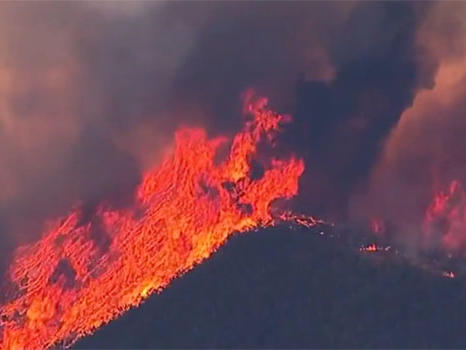
Western wildfires: 8 ways to protect your property
The wildfires burning in California today—like the Wragg fire near Lake Barryessa (pictured) and in various spots around the West, including Glacier National Park, Montana—are stark reminders: Our grassy and forested landscapes are crackling dry from drought, and the wildfire season is heating up. What to do? Read on…

Photograph by CBS News
The wildfires burning in California today—like the Wragg fire near Lake Barryessa (pictured) and in various spots around the West, including Glacier National Park, Montana—are stark reminders: Our grassy and forested landscapes are crackling dry from drought, and the wildfire season is heating up. What to do? Read on…
1. Clean up brush
Experts warn that our wildfire seasons are coming earlier and staying longer these days. And in California, dry chaparral produces fast-moving firestorms, particularly during Santa Ana winds. Coastal sage becomes tinder 7- to 10 years after a burn, chaparral 15 to 20 years after a burn. Thin, prune, and rake your property of crackling dry debris regularly so it stays fire resistant.
2. Maintain an irrigated greenbelt
Within 30 feet of the house, keep plants well maintained and irrigated. In drought-stricken California, where water cutbacks are in place, use soaker hoses, drip irrigation, or shower water collected in buckets from indoor showers.
3. Clear out the clutter
Clean dead leaves and other plant debris from your home’s roof and gutters, and rake up fallen leaves. Avoid storing firewood next to the house.
4. Prune trees and shrubs
Cut back any tree branches overhanging your roof to within 15 to 20 feet of the house, and keep shrubs growing next to the house at under 1 1/2 feet tall. In heavily wooded areas, cut down any week or diseased trees, and eliminate fire “ladders”—plants of different heights that form a continuous fuel supply from the ground up into the tree canopy.
5. Be ready to use the pool
A gasoline-powered fire hose (off the grid, it works even when electricity is lost) can let firefighters make use of the 21,000 gallons of water a pool can hold. (That’s about the amount needed to save a 2,000-square-foot home). If you don’t have a swimming pool, you could install a cistern or rain barrels.
6. Prep the house
Consider replacing a shake roof with composition shingles, slate, or ceramic tiles, and standard windows with double-paned tempered glass which reduces heat transfer through glass. Eliminate eaves or enclose them with stucco or other nonflammable material. Cover vents with 1/4-inch wire mesh. When fire approaches, block the vents with precut plywood. Use non-flammable masonry or wrought iron for fences, railings, and walls that adjoin the house. Enclose decks in wild land areas with skirts of concrete, stucco, or other non-flammable materials. Or use oversize timbers (6-by-6 inch posts and beams) to build them.
7. Choose the right plants
There’s no such thing as a fire proof plant—any plant will burn if the flames are hot enough, and wildfires can reach 900°. But some can slow a fire of they’re watered and tuned regularly. Visit a firewise garden near you (or their informative websites), to learn more about protecting your home and garden from wildfires. The City of Santa Barbara Firescape Demonstration Garden, and the Fire Safety Garden at the San Diego Botanic Garden, are examples. For more choices, visit websites such as Calfire.org or, in the Pacific Northwest, FireFree.org
8. Going camping? Be prepared
Get necessary campfire permits and learn to have a safe campfire in advance of your trip. And bring along an emergency preparedness kit, with a radio such as American Red Cross Solarlink, a flashlight, a durable map on which you can highlight (in neon) at least two possible evacuation routes.

